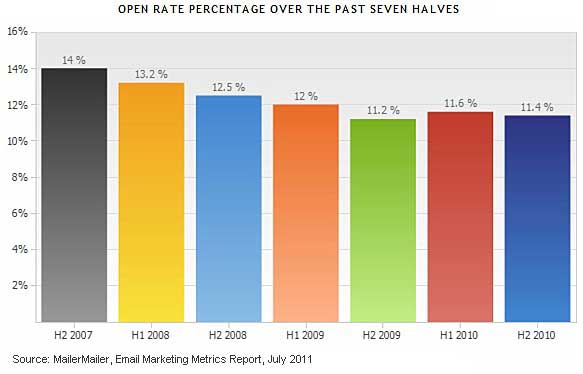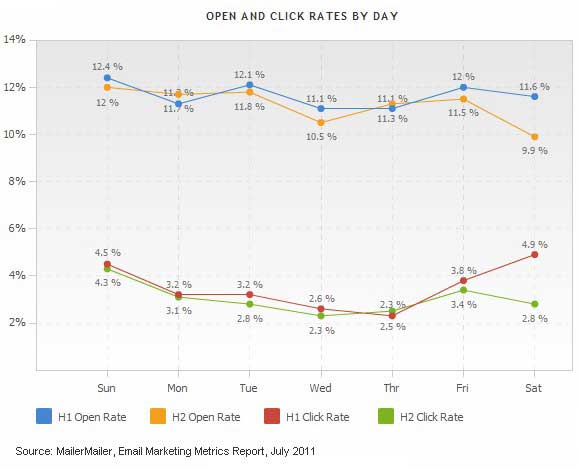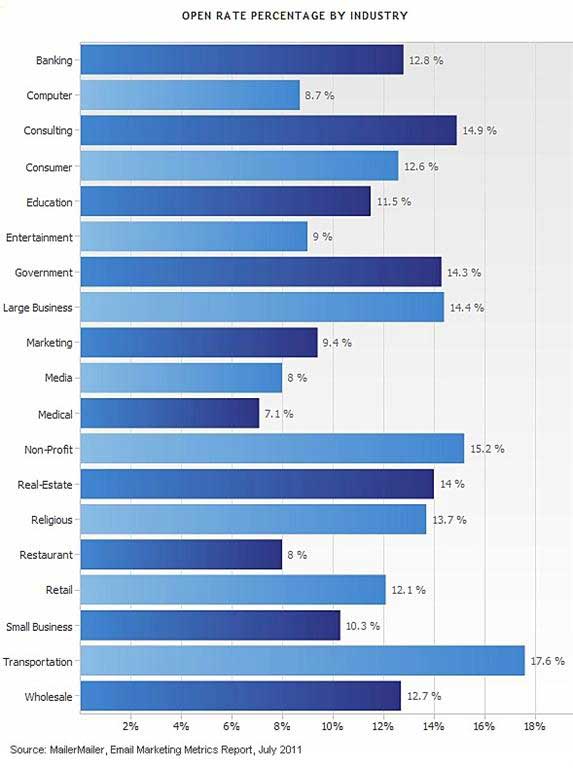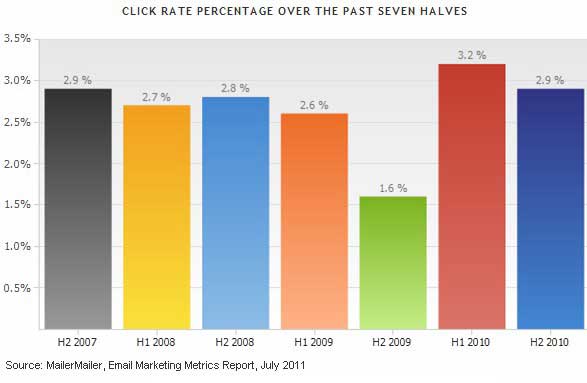Email open rates continued to languish in 2010, though performance levels varied dramatically by industry, whereas click rates improved during the year, according to a report by MailerMailer, which also found that most people tend to open email between seven and ten in the morning.
The average overall unique open rate* at the end of 2010 was 11.4%, up 0.2 percentage points from 11.2% a year earlier.

Though factors such as image blocking, rising use of smart phones, and list fatigue are often cited for open rate decline, another element influencing open rates is the increasingly large volume of emails that subscribers regularly receive, according to the report.
Below, additional findings from the July 2011 edition of the Email Marketing Metrics Report, including the best day to send email and open and click rates by industry and list size.
Some key findings:
- Subject Lines: Emails with shorter subject lines tend to outperform those with longer lines: Subject lines of 4-15 characters generated a 14.1% open rate, whereas those containing 51 or more characters had the least amount of opened emails (9.9%). The highest click rates were generated by emails with subject lines between 16 and 27 characters long (4%). Interestingly, the category which generated the most opens did not generate the highest click rate: Subject line lengths with 4-15 characters generated a 3.1% click rate.
- Bounces by mailing frequency: Marketers sending emails more frequently garner fewer bounces. Emails sent to subscribers less than once a month (5.1%) generated the highest bounce rate, whereas those sent more frequently, such as once a day or more, registered the smallest bounce rate (0.4%).
- Personalization: Emails containing personalization in the actual message registered open rates of 12.6% on average, compared with those containing personalized subject lines only (4.1%). Click-rate trends closely mirror open-rate trends: Messages that contained a personalized subject line only generated a 0.8% click rate, whereas personalization in the message portion of the email generated a 3% click rate.
Morning is E-mail Prime Time
Email marketers who schedule their email campaigns to be delivered between 1:00 AM and 5:00 AM can expect higher volumes of email opens and clicks, MailerMailer found.
A similar trend was evident in the early evening, following regular business hours: Email marketers who scheduled their emails to be delivered between 6:00 PM and 7:00 PM local time, for example, experienced a considerable jump in their open and click rates.
Overall, emails are typically opened during the morning hours between 7:00 AM and 10:00 AM. During that period, email open rates maintain a steady climb until noon, at which point open rates begin to slowly decline.
Check out MailerMailer's Interactive chart, Email Opens by Time of Day, for detailed stats.
Best Day to Send Email: Sunday
Emails sent on Sundays during the 2010 registered the highest average open and click rates, 12.2% and 4.4%, respectively ( up from 2009 levels, 14.1% and 12.2%, respectively.) Overall, click rates were lowest on Tuesday, Wednesday and Thursday.

Open rates were generally lower during the second half of the year, with a considerable drop off on Saturdays, likely indicating that fewer emails were sent on Saturdays from July to December.
Subscribers recorded the highest engagement (via clicks) during the weekends.
Open Rates by Industry
Transportation (17.6%), non-profit (15.2%) and consulting (14.9%) were the top performers in 2010 whereas media (8%), restaurant (8%) and medical (7.1%) recorded the lowest email open rates.

Looking for great digital marketing data? MarketingProfs reviewed hundreds of research sources to create our most recent Digital Marketing Factbook (May 2010), a 296-page compilation of data and 254 charts, covering email marketing, social media, search engine marketing, e-commerce, and mobile marketing. Also check out The State of Social Media Marketing, a 240-page original research report from MarketingProfs.
Click Rates Improve
The average overall unique click rate** at the end of 2010 was 2.9%, up from 1.6% one year earlier. Similar to open rates, click rates registered a decline from the first half to the second half of 2010.

The positive click-rate trend likely signals that email marketers are maintaining lists and ensuring links work properly, and becoming savvier overall with how they create, design, and distribute their email campaigns.
In addition, an increase in the click-rate trend may indicate that messages are becoming more relevant and contain clearer calls-to-action messaging.
Click Rates by Industry
Click rates also varied widely by industry, with some sectors' click rates at 9% or more and others' at 1% or less. The top-performing industries in 2009 were the following:
- Consumer: 4.9%
- Transportation: 4.6%
- Consulting: 4.5%
- Real-Estate : 4.4%
The industries with the lowest click rates were the following:
- Education: 1.4%
- Government: 1.2%
- Medical: 1.1%
- Restaurant: 0.4%
*Open rate is calculated by dividing the number of email messages opened by the total number of email messages sent.
**Click rates are calculated by dividing the total number of unique clicks by the product of the number of links in each message and the number of total recipients.
About the data: The data for this report is based on the study of 977 million email messages sent by MailerMailer customers (roughly 87,000 newsletter campaigns) from Jan. 1 to Dec. 31, 2010, to a minimum of 25 recipients.



